
About UsThe Numismatic Bibliomania Society is a non-profit organization promoting numismatic literature. For more information please see our web site at coinbooks.org SubscriptionsThose wishing to become new E-Sylum subscribers (or wishing to Unsubscribe) can go to the following web page link MembershipThere is a membership application available on the web site Membership Application To join, print the application and return it with your check to the address printed on the application. Membership is only $15 to addresses in the U.S., $20 for First Class mail, and $25 elsewhere. For those without web access, write to: David M. Sundman, Secretary/TreasurerNumismatic Bibliomania
Society AsylumFor Asylum mailing address changes and other membership questions, contact David at this email address: dsundman@LittletonCoin.com SubmissionsTo submit items for publication in The E-Sylum, just Reply to this message, or write to the Editor at this address: whomren@coinlibrary.com
BUY THE BOOK BEFORE THE COINYou won't regret it! |
- WAYNE'S WORDS: THE E-SYLUM APRIL 10, 2011
- THE E-SYLUM GOES MOBILE
- NEW BOOK: EARLY QUARTER DOLLARS OF THE UNITED STATES 1796-1838
- BOOK REVIEW: THE SECRET HISTORY OF THE FIRST U. S. MINT
- MANTIS: AMERICAN NUMISMATIC SOCIETY COLLECTION DATABASE
- MORE ON LEN HARSEL, 1935-2011
- NUMISMATOURIST HOWARD BERLIN VISITS BUDAPEST, BELGRADE AND ZAGREB
- THE RATS OF TOBRUK MEDAL
- MORE ON COUNTERFEITER "MR. 800"
- QUERY: INFORMATION ON NUMISMATIST J.E. BULL SOUGHT
- QUERY: WHO IS THIS MYSTERY EXONUMISMATIST?
- NOTES FROM E-SYLUM READERS: APRIL 10, 2011
- NUMISMATICS FOR LOCAL HISTORY
- SALVORS CLAIM FIND OF OLDEST COLONIAL SHIPWRECK IN THE CARIBBEAN
- UPDATE ON LIBERTY DOLLAR PROMOTER BERNARD VON NOTHAUS
- ARTICLE PROFILES ROSA NEPHEW'S COIN REPRODUCTIONS
- ARMY DOG WINS AUSTRALIA'S PURPLE CROSS FOR ANIMALS
- SOMERSET COIN HOARD IMAGES
- FEATURED WEB SITE: COIN MATERIALS
WAYNE'S WORDS: THE E-SYLUM APRIL 10, 2011

Among our new subscribers this week are Ryan Baum, courtesy of John and Nancy Wilson, and Nevin Greninger, Tom Franczyk and Phil Christ, all courtesy of Ed Krivoniak. Welcome aboard!
We now have 1,415 email subscribers, plus 130 followers on Facebook, including Brandon Katrena and Norbert Wegmann.
This week we open with the announcement of a new way to read The E-Sylum - on your phone! Next we have the announcement of a new book on Early U.S. Quarters and a review of The Secret History of the First U.S. Mint. Other topics include museums in Budapest, Belgrade and Zagreb.
To learn more about the Rats of Tobruk, 'Mr. 880', and the "High Priest" of the "Free Marijuana Church" , read on. Have a great week, everyone!
Wayne Homren
Numismatic Bibliomania Society
THE E-SYLUM GOES MOBILE
We're working on an E-Sylum SmartPhone app for the iPhone and Android phones. The app is based on our RSS feed, which delivers each issue as a set of clickable headlines. The RSS feed is usually updated by midmorning Monday following our Sunday night publication. Many thanks to John Nebel for writing the RSS feed code and maintaining the feed on his servers. I paid a company to plug our feed into one of their standard app configurations and publish it. Below are some mockups.

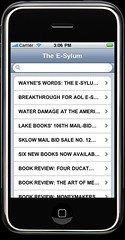
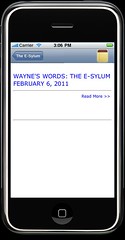
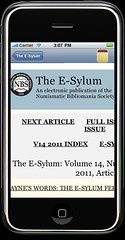
The Android version is still under development, but the Apple version is available now. Jon Radel tested it out. He writes:
It works and would serve for reading the current issue if I otherwise didn't have access. It doesn't appear to buy me much over just reading the issue using my Safari browser. I find the linear experience more to my liking than to navigate into a story and then back out and then into the next story. (A "next story" button *would* be nice.) While I don't read every word of every E-Sylum, I almost always at least skim the whole thing.
I agree that the navigation could be improved. My goal would be to have an app that works more like The New York Times app I use every day, with an easy way to flick from story to story with a swipe of your finger. But the RSS template was something we could get up and running quickly and cheaply. As Jon says, it's a nice way to get access to The E-Sylum on the go. In fact, the next time we run into a problem with the Binhost email servers, app readers could be reading their issue before the email gets out.
Please do download the app and give it a try. Let us know what you think!
NEW BOOK: EARLY QUARTER DOLLARS OF THE UNITED STATES 1796-1838
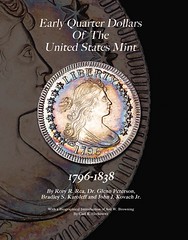 Early Quarter Dollars of the United States Mint 1796-1838 is the culmination of over a decade of research by the authors into the early quarters from the first US Mint. Rory has spent countless hours photographing many of the most amazing examples in existence. We have included quick attribution tips to assist the collector in rapidly identifying the die marriage of his quarters. We have also included history vignettes to put the issuance of the coins into perspective. Examples of the pages are presented in the following pages.
Early Quarter Dollars of the United States Mint 1796-1838 is the culmination of over a decade of research by the authors into the early quarters from the first US Mint. Rory has spent countless hours photographing many of the most amazing examples in existence. We have included quick attribution tips to assist the collector in rapidly identifying the die marriage of his quarters. We have also included history vignettes to put the issuance of the coins into perspective. Examples of the pages are presented in the following pages.
We have also included many other features in our work including an introduction by John McCloskey, a history of Ard Browning by Carl Herkowitz, comments on the E and L counter stamps and notes on the Browning Plate Coins by Ted McAuley, W. David Perkins, Rory Rea and Eric P. Newman, followed by the pedigree of the known Browning Plate Coins. A dedication to Charlton "Swampy" Meyer, the only collector to complete a 1796-1838 quarter marriage set, is next. Bust quarter errors and counter marked quarters are covered in the following two sections. We have also listed the quarters present in the Smithsonian Collection and the American Numismatic Society Collection. We hope you are as excited with this work as we are in bringing it to you.
Regular Hard Bound Edition: $110 delivered USPS Priority Mail.
Limited Edition Leather Bound Edition with Eric P. Newman Plates*: $500 delivered. Optional cloth slip case to protect the binding from damages: $50.
*Limited to 50 numbered autographed copies. Delivery expected late 2011. A $100 deposit will hold your order until binding begins when the balance will be due.
Order from:
Brad Karoleff
8077B Connector Dr.
Florence, KY 41042
bkaroleff@yahoo.com
859.371.1414
Make checks payable to: Browning Quarter Book.
For more information, see: www.browningquarterbook.com
BOOK REVIEW: THE SECRET HISTORY OF THE FIRST U. S. MINT
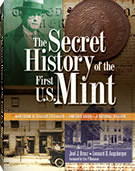 The Secret History of the First U. S. Mint, Authors Joel J. Orosz and Leonard D. Augsburger, Foreword by Eric P. Newman, Whitman Publishing, LLC, 2011, Reviewed by John and Nancy Wilson, NLG
The Secret History of the First U. S. Mint, Authors Joel J. Orosz and Leonard D. Augsburger, Foreword by Eric P. Newman, Whitman Publishing, LLC, 2011, Reviewed by John and Nancy Wilson, NLG
The Secret History of the First U. S. Mint – How Frank H. Stewart Destroyed – And Then Saved A National Treasure by dynamic and award-winning authors Joel Orosz and Leonard Augsburger. It is a well written and informative hardcover reference containing 336 pages, full of color plates. The majority of information, as well as photos have never been published. This is another can't miss publication for Whitman that once you start reading it is hard to put down.
The two page preface for this book gives the reader insight into how the authors came together to co-author this reference. Leonard Augsburger was originally focused on his "Treasure in the Cellar," and Joel Orosz on the 1792 half disme and Dunsmore's celebrated painting, "Washington Inspecting the First Money Coined by the United States". From that small beginning doors started opening and more information was found regarding the First U. S. Mint and Frank H. Stewart. Sherlock Holmes would be very proud of the co-authors of this reference for going the extra mile with their 15 weeks in researching information for the reference.
We especially liked how the reference was organized. Following the Foreword and Preface was the Acknowledgments which covered about 107 names. The eight page Introduction on "The Declaration House: Foreshadowing of the First Mint's Fate," quoting the reference "How did a modest farmer's son named Frank Huling Stewart grow up to buy the first U. S. Mint?" How did he "become the villain who demolished it?" These and many other questions will be answered in this introduction, as well as the ten chapters that follow.
Following the Chapters is an Afterword: The Mint as It Was, the Mint as Stewart Fixed It in Memory. These seven pages are full of historical information. We liked and quote, "The Mint, as Stewart fixed it in our memories, was a place of productivity, where workers stood at their posts efficiently striking the coin of the realm. The Mint as it actually existed was a place of backbreaking labor, requiring of its employees 11-hour days and six-day workweeks." Wow, and today we hear talk of a four day workweek.
The book covers in great detail the various construction and fire at the mint from 1792 until it was sold at auction in 1835. Frank Stewart bought the mint in 1907.
Mr. Stewart's collection of early coins from 1792 to 1812 is discussed in detail. It is interesting to note that Stewart was not a coin collector in our terms as he had no interest in the condition of his coins or the completeness of his collection. The gold areas were covered only to the half-eagle. Stewart expressed an interest in the 1804 dollar but would not spend the $3,600 one would cost at the time even though he had the means to purchase it. Stewart wrote an indispensable history of the first mint, History of the First United States Mint in 1924. Most of what we know about the first mint buildings we know because of Frank Stewart's exertions. Stewart's commissioned artworks were: John Ward Dunsmore's Inspection of the First Dies and Washington Inspecting the First Money Coined by the United States, Edwin Lamasure's Cradle of Liberty and Ye Olde Mint. The details of these artworks were explained from conception to preservation.
Appendix A to E cover
The 21 pages of notes cover all the sources that were used for the reference. The Selected Bibliography will give bibliophiles references that might help them find information for projects they are working on and the Index will take them directly to information that is needed immediately.
It is great that these two authors have come together to present to us, "The Secret History of our First U. S. Mint". It helps to answer just about any question that anyone would have on our first U. S. Mint, its operation and history right down to the hours employee's worked coining our first money. We think this well written reference will be of interest to both numismatists and historians. It should also be in every library in the United States. It is so well done it will probably challenge for numismatic book of the year.
The reference lists for $24.95. For information on purchasing it you can contact the publishers at: Whitman Publishing, LLC, 3103 Clairmont Rd., Suite B, Atlanta, GA. 30329 or visit their web page, info@whitmanbooks.com or call, (800) 546-2995.
BUY AND SELL THE SMART WAY!
MANTIS: AMERICAN NUMISMATIC SOCIETY COLLECTION DATABASE
American Numismatic Society Director Ute Wartenberg Kagan today unveiled the new interactive ANS collection search tool, MANTIS (Mantis: A Numismatic Technologies Integration Service) provides access to all 600,000 records for objects in the ANS collection, through a series of new, easy-to-use search screens.

The new search tool is an open source implementation of several applications used in the Library, Archive, and Museum communities, including Apache Solr for faceted searching. The tool enables users to interact with the ANS collection through keyword searches or by browsing and sorting on numerous categorical and physical attributes common to numismatics. This search tool connects individual objects together by these searchable attributes, allowing users to seamlessly navigate from one object to its relations.
ANS Director Wartenberg explains, "The collections database is the work of a generation of expert cataloguers, and was originally designed to allow curatorial staff to manage the massive holdings of the Society.MANTIS marks a huge leap forward in making this work available to the general public in a way that is easy to understand for specialist and non-specialist alike. Together with DONUM, our bibliographic search tool, the release of MANTIS places the ANS at the forefront of numismatic research on the World Wide Web."
The Database breaks down into 11 Departments, which can be searched as a whole or individually.Approximate totals for each department are as follows:
Greek 100, 000
Roman 80, 000
Byzantine 15, 000
Islamic 60, 000
East Asian 45, 000
South Asian 50, 000
Medieval 50, 000
Modern 100, 000
United States 25, 000
Latin America 20, 000
Medals and Decorations 50, 000
Traditional searches by mint person, date and numismatic categories are catered for, and supplemented with a new map interface.This latter feature, still under development, will eventually allow the user to find coins, medals and banknotes issues around the world by clicking on points on a map.
"The release of the new research tool is an exciting development, not just for the access it provides to our remarkable collection," notes ANS Deputy Director Andrew Meadows. "It also harnesses an ANS initiative to create stable identities for numismatic concepts on the World Wide Web through the nomisma.org project.This is most visible at the moment in the mapping functions that we offer, but will ultimately extend to the creation of other exciting new tools."
The design of MANTIS is the work of ANS Web Developer Ethan Gruber, working in close collaboration with ANS Research Scientist Sebastian Heath.
Heath explains: "The new ANS database is now positioned to become a tool for expressing all the links inherent in each individual coin. We can already see this in the powerful mapping function. Even at this early stage of development users can browse the Greek and Roman departments by geography, with an expanding set of North American mints also coming available. It's already possible to make maps of similar coins, such as those showing Greek and Roman deities, and this functionality will become available for more coins as Ethan Gruber continues his work. The database also supports a variety of export formats that will encourage exploration of the links between numismatics and other disciplines. Underlying much of our work is a technical approach called 'Linked Open Data'. As the humanities increasingly embrace digital tools, researchers of all stripes can be confident that the ANS is bringing exceptional resources into their domains."
To read the complete article, see: American Numismatic Society Collection Database (numismatics.org/search/)
To read the complete press release, see: AMERICAN NUMISMATIC SOCIETY UNVEILS MANTIS: A MAJOR NUMISMATIC RESEARCH TOOL (numismatics.org/wikiuploads/NewsEvents/MantisPressRelease1.pdf)
MORE ON LEN HARSEL, 1935-2011
Howard A. Daniel III writes:
The attached was given out to everyone at Len's memorial service. E-Sylum readers can go to the Fairfax Memorial Funeral Home website at www.fmfh.com and leave a message for his family and friends. And in lieu of flowers, his family would like donations in Memory of Leonard W. Harsel to Ripon College, c/o Larry Malchon, P.O. Box 248, Ripon, WI 54971.
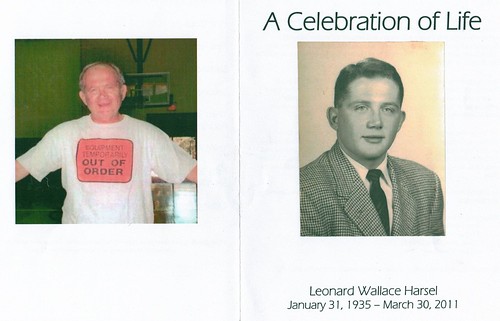
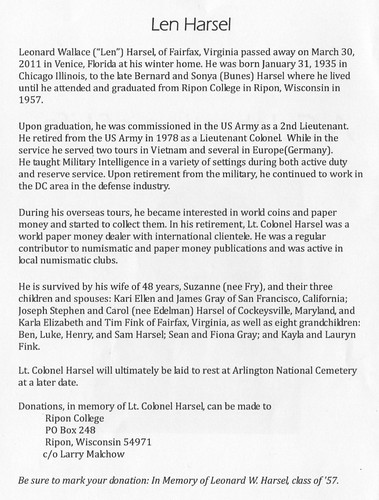
Jon Radel writes:
I can't claim to be one of Mr. Harsel's biggest or longest-term customers, having started buying notes from him only towards the very end of his career as a dealer. However, particularly these days when it seems that every other public mention of dealers is about how as a class they're too quick to snub young beginners, I remember well a visit to Mr. Harsel's table in Baltimore a couple of years ago.
My son, 7 or thereabouts at the time, had recently discovered watermarks and was fascinated by them. While I went through the stock looking for items to purchase I noted that a lengthy, and very gracious on Mr. Harsel's part, conversation was developing about watermarks. It culminated in Mr. Harsel actually pulling the proceeds of the show out of his pocket so that my son could compare the watermarks on current US notes with the foreign notes.
Dick Doty writes:
Len Harsel was a great person - friendly, always welcoming to new collectors, one of the pillars of the Vienna Show. He'll be missed.
To read the earlier E-Sylum article, see: LEN HARSEL, C1940-2011 (www.coinbooks.org/esylum_v14n14a06.html)
THE BOOK BAZARRE
NUMISMATOURIST HOWARD BERLIN VISITS BUDAPEST, BELGRADE AND ZAGREB
Your humble Numismatourist has just returned from his first trip of the 2011 travel season and was fortunate to have visited three numismatic venues – one that was unexpected.
When in Budapest, there was a short run exhibition of the gold treasure of Košice at the Hungarian National Museum. Located on the city's "Buda" side of the Danube, the treasure is being displayed in the museum's Strong Room, where the coronation mantle is normally kept. The hoard, regarded as one of the 20th century's most sensational finds, consists of 2,920 gold coins, three medals, and a 2-meter gold chain. These were found in 1935 in a copper casket during the renovation of the Košice's Financial Directorate's building. It is thought that it was probably hidden by a high ranking Habsburg administration official. 85% coins are Hungarian, Transylvanian, and Dutch, but there are also Bohemian, Silesian, Polish, German, Danish, Swedish, Italian, Austrian, Salzburg, and Spanish issues. The oldest coins are the gold florins of the Hungarian king Sigismund of Luxemburg, minted between 1402 and 1404. The "newest" are ducats of King Leopold I, minted in Kemnica in 1679. The most valuable item of the hoard is a unique 1541 medal of Ferdinand I.
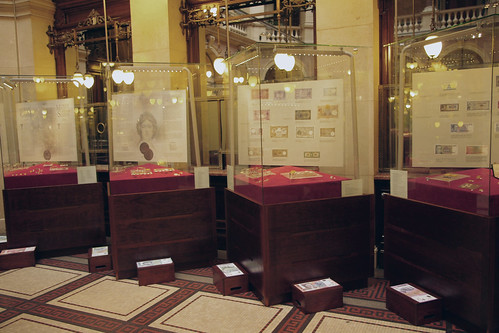
 I then traveled to Belgrade and while there, I visited the National Bank of Serbia which has a permanent exhibit of coins and banknotes. The exhibit covered the history of coins from the ancient world to the present, including the former Yugoslavia and its inflationary period of the early 1990's. Among the exhibits were three bars, all physically the same size, inside a protective transparent case (probably bulletproof also). Each bar - 5 kg iron, 12.5 kg gold, and 7.4 kg lead, had a protruding handle in which you could lift each bar to feel how heavy each one was in comparison. There were exhibits on security features of the Serbian, Euro, and U.S. paper money. In addition the museum was exhibiting a temporary exhibit of coins and banknotes from Brazil. One highlight for me was that I was able to print a souvenir 1-dinar banknote with my picture as a portrait and watermark. Actually, there is no current 1-dinar banknote, only the coin.
I then traveled to Belgrade and while there, I visited the National Bank of Serbia which has a permanent exhibit of coins and banknotes. The exhibit covered the history of coins from the ancient world to the present, including the former Yugoslavia and its inflationary period of the early 1990's. Among the exhibits were three bars, all physically the same size, inside a protective transparent case (probably bulletproof also). Each bar - 5 kg iron, 12.5 kg gold, and 7.4 kg lead, had a protruding handle in which you could lift each bar to feel how heavy each one was in comparison. There were exhibits on security features of the Serbian, Euro, and U.S. paper money. In addition the museum was exhibiting a temporary exhibit of coins and banknotes from Brazil. One highlight for me was that I was able to print a souvenir 1-dinar banknote with my picture as a portrait and watermark. Actually, there is no current 1-dinar banknote, only the coin.
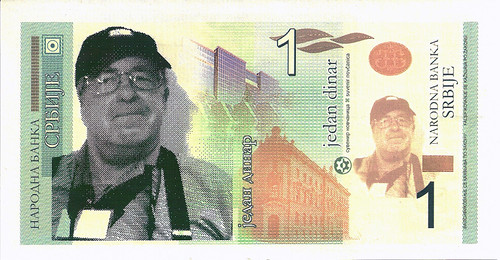
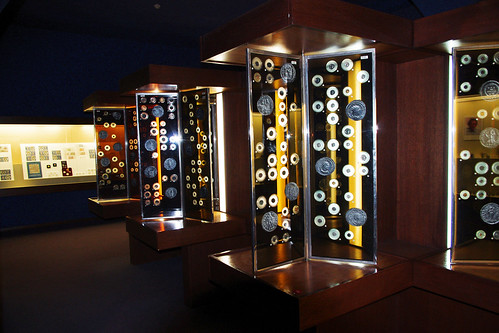
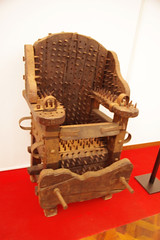 From Belgrade I flew to Zagreb, via Budapest, rather than take the long train ride. There the Archeological Museum has an exhibit of coins throughout several floors. At the same time, the museum had an exhibition of medieval torture instruments. I especially liked this "office chair." Actually, it is an "interrogation seat," used in central Europe. The "accused" (who was almost found guilty) was placed naked in this seat in such a way so that any movement would cause his/her skin to be pierced by the spikes (ouch!).
From Belgrade I flew to Zagreb, via Budapest, rather than take the long train ride. There the Archeological Museum has an exhibit of coins throughout several floors. At the same time, the museum had an exhibition of medieval torture instruments. I especially liked this "office chair." Actually, it is an "interrogation seat," used in central Europe. The "accused" (who was almost found guilty) was placed naked in this seat in such a way so that any movement would cause his/her skin to be pierced by the spikes (ouch!).
This torture (I guess this would have to be defined as such by Obama and the Supreme Court) would last several hours and the tormentor heightens the pain by striking the victim's limbs or other methods, i.e., pliers, etc. One of the museum's highlights is what is called the "Zagreb Mummy," which was discovered in Egypt in the 19th century and carried back to Yugoslavia by a traveler. The Zagreb Mummy was found to be wrapped in a linen book printed with the longest only existing Etruscan text. It is mostly untranslated, as such little knowledge of the language exists. However, it is believed to be a ritual calendar.
Next trip is in May: Milan, Genoa, Bologna, and San Marino (several numismatic venues here in the world's oldest sovereign state)
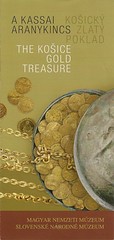 Coincidentally, Dave Hirt mailed me something a week or so ago about the exhibit in Budapest. With my computer problem I didn't have time to scan and publish it, but this is a great opportunity.
-Editor
Coincidentally, Dave Hirt mailed me something a week or so ago about the exhibit in Budapest. With my computer problem I didn't have time to scan and publish it, but this is a great opportunity.
-Editor
Dave Hirt writes:
In Budapest I viewed this numismatic gold hoard found in Slovakia in 1935. The condition of these coins was quite amazing. They looked like they were just minted. There were some very rare coins among them. It was quite enjoyable for me.
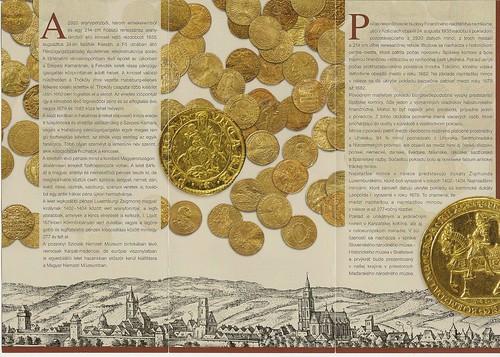
THE RATS OF TOBRUK MEDAL
Web site visitor Damien Lewis writes:
I saw this old entry on the net about the Rats of Tobruk medal that was made by the men of Tobruk. I thought I would see if you every found out about it. The only reason I ask is that I have one (my mums uncle was a Rat) and was doing some personal research on it. If you were still interested after all this time I can send you a photo.

The Sydney Morning Herald this week published a story about a reporter's visit to the Libyan city of Tobruk, which was a focal point for Australian servicemen in World War II. The article mentions a medal created by the soldiers.
"A pilgrimage to the bustling Libyan city turns up poignant reminders of Australian soldiers in the siege of Tobruk, Anthony Ham writes.
"Few names resonate through Australian history like Tobruk. It is a place that has become central to our understanding of who we are as Australians. Like Gallipoli, it is a battlefield where the legend of the Anzacs was forged. And like the Somme it is a place where thousands of Australians lie buried."
"... with the soldiers hunkered down in trenches and in caves such as these, a Radio Berlin announcer dismissed the Australians as the "rats of Tobruk", drawing a parallel with rodents burrowing underground. Designed to bolster German propaganda and destroy Australian morale, the name was instead quickly adopted by the Australians as a badge of honour. One of the most famous photos of the siege shows a Bren gun carrier adorned with the words "Rats to you". The Australians also amused themselves by designing an unofficial medal from the metal of a downed German plane with a rat as its centrepiece."
To read the earlier E-Sylum article, see: RATS OF TOBRUK MEDAL INFORMATION SOUGHT (www.coinbooks.org/esylum_v10n16a18.html)
To read the original Sydney Morning Herald article, see: Rats to you (www.smh.com.au/news/africa/rats-to-you/2007/04/18/1176696918167.html)
MORE ON COUNTERFEITER "MR. 800"
Bob Leuver writes:
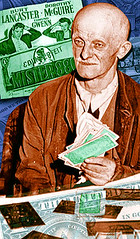 In your latest issue of E-Sylum you asked about the derivation of the title "Mr. 880."
I have two sources with the identical conclusion.
In your latest issue of E-Sylum you asked about the derivation of the title "Mr. 880."
I have two sources with the identical conclusion.
I was told this story back in the early '80 by an Assistant Director of the Secret Service. Also, the original articles from the New York Times also indicates the same derivation of the title.
The New York office of the Secret Service began filing the counterfeits in question in a file labeled "880." Hence the name of the suspect, Mr. 880. No one would ever suspect a woman to be a counterfeiter. File #880. "Nevertheless, a fake is a fake, so the Secret Service dutifully opened a file, No. 880, put a New York City map on the office wall and, with a red thumbtack, marked the spot where the bill was passed."
Ken Hallenbeck adds:
A few years ago the American Numismatic Association summer seminar had a man from the Secret Service named Mark Surrency, if I recall correctly, who came out to take a class on paper money. He was the Service's expert on counterfeit currency. Kind of a neat thing to have a currency expert named Surrency. Anyhow, I sat next to him in class and we got acquainted. He then was talked into teaching a class on counterfeit currency the following year. I asked him to bring the famous 880 one dollar bill the next year, which he did. It was interesting seeing the actual note. I had seen the mister 880 movie some time before that. Mark was around for 3 or 4 years numismatically. I heard later that he had gone to another part of government.
To read the earlier E-Sylum article, see: FINDING 'MR. 880': THE CASE OF THE ONE-DOLLAR COUNTERFEITER (www.coinbooks.org/esylum_v14n14a13.html)
QUERY: INFORMATION ON NUMISMATIST J.E. BULL SOUGHT
In working on our New Jersey Copper book, I have run across a J.E. Bull who appears to have been an active buyer in the Parmelee sale, well coached by Maris and Steigerwalt, and someone who assembled one of the nicer collections of New Jersey Coppers. Based on his purchases in Parmelee alone, he deserves a place in our "Collectors and Collections" chapter. He also fills in a number of missing provenances.
So I am wondering if our incredible community of numismatists and bibliophiles have any information they can share about him or his collecting activities. In particular, any information on how he disposed of his coins, some of which appear to have gone to the likes of Ellsworth, Mills, Ryder etc.
It appears Bull lived in Centrebrook, Connecticut. It looks like Steigerwalt was coaching him on purchases based on some old postcards Roger Moore was able to share with me, so maybe Steigerwalt handled the sale privately. A very quick initial search of the ANS Library did not come up with any J.E. Bull sale. As always, many thanks to you and our readership.
QUERY: WHO IS THIS MYSTERY EXONUMISMATIST?
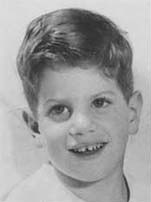
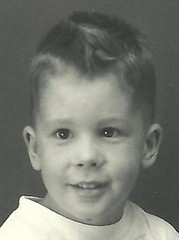
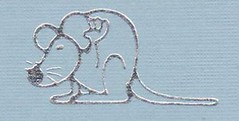 Speaking of Steve Tanenbaum, David Gladfelter forwarded an image of one of Steve's business cards from his Rossa and Tanenbaum days. Here's a closeup of their rat logo (R.A.T. as in Rossa And Tanenbaum). Thanks!
-Editor
Speaking of Steve Tanenbaum, David Gladfelter forwarded an image of one of Steve's business cards from his Rossa and Tanenbaum days. Here's a closeup of their rat logo (R.A.T. as in Rossa And Tanenbaum). Thanks!
-Editor
David writes:
It looked more like a mouse to me. Didn't know until now what it stood for.
To read the earlier E-Sylum article, see: STEVE TANENBAUM TRIBUTE WEB SITE (www.coinbooks.org/esylum_v14n14a07.html)
NOTES FROM E-SYLUM READERS: APRIL 10, 2011
Pete Smith writes:
I was looking forward to this issue of the E-Sylum to see if you sneaked in any April Fool's joke. I see that you left this task to Ken Bressett. Although Len and Joel have never picked up the tab for dinner with me, I can believe that this may have actually happened.
To read the earlier E-Sylum articles, see:
MORE ON THE FRANKLIN MINT COLLECTOR'S SOCIETY
(www.coinbooks.org/esylum_v14n14a12.html)
WAYNE'S NUMISMATIC DIARY: APRIL 1, 2011
(www.coinbooks.org/esylum_v14n14a17.html)
Jim Duncan writes:
One hesitates to argue with the BBC, but I had always understood that Ralph Heaton II was born in 1794. Is it fair to say the mint started in 1794? I don't think so. J O Sweeny's book on The Mint says (p3) that "it can be confidently stated that the firm known today as The Birmingham Mint was founded by Ralph Heaton II in about 1817."
To read the earlier E-Sylum article, see: BIRMINGHAM MINT RELOCATES (www.coinbooks.org/esylum_v14n14a20.html)
P.K. Saha forwarded an image of a new five Euro coin from Italy. I like it! Thanks.

NUMISMATICS FOR LOCAL HISTORY
Coin and currency enthusiast Alex Armstrong of Hillsborough, North Carolina, has a sentiment in which I strongly endorse. Alex believes local areas should have examples of numismatic items used in that area in the past. If the locale does not have a local history museum, there should be some repository for locally used numismatic items.
A news story was published this week that Alex donated eight coins -- British pennies and halfpennies -- to the town as a gift to be viewed by the residents. The story reveals the coins were not that rare or expensive, but were significant. These were the coins that circulated in the area in the 1700s.
Alex Armstrong has designed archival containers for major coin collections at the Smithsonian as well as for universities such as Harvard and Princeton. He creates these for both coins and currency. But for his hometown he donated coins a resident could touch, to feel the history in their hands, perhaps to be influenced by its heritage.
To Alex's concept of coins and paper money, I would like to add the wider scope of medals. Local museums should have medals of local events and local people. Medallic portraits alone are as informative as any other museum artifact. Thank you Alex.
To view the article, click on: ‘Give it as a gift to the town' (www.aconews.com/articles/2011/04/08/noc/news/news2.txt)
SALVORS CLAIM FIND OF OLDEST COLONIAL SHIPWRECK IN THE CARIBBEAN
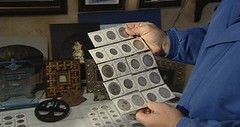 A Midvale, Utah based underwater exploration and recovery company, Deep Blue Marine, Inc., has discovered what they believe to be the oldest colonial shipwreck in the Caribbean.
A Midvale, Utah based underwater exploration and recovery company, Deep Blue Marine, Inc., has discovered what they believe to be the oldest colonial shipwreck in the Caribbean.
"We have found a shipwreck that we can definitively date back to 1535," Deep Blue Marine CEO Wilf Blum said. "We have also found artifacts that are still in the Dominican Republic that date back to the pre-Columbian era. When you think about that, this is significant. This shipwreck is just a few years after Columbus and it is the single oldest shipwreck ever found in the Caribbean. We think this is something noteworthy."
Deep Blue Marine, Inc. has built a relationship with the government of the Dominican Republic and has secured a contract with the sub-aquatic ministry. This specific discovery has been named after the captain of the ship, Capt. William Rawson. Rawson's wreck is one of many sites the company is currently exploring.
The company found Rawson's Wreck by obtaining an ancient coin from a local fisherman.
"We found it was the oldest coins ever minted in the new world. We did some more research on where the (local fisherman) found the coin and little by little we found pieces of the shipwreck, which led us to where we are now," Rawson said.
"We have artifacts here that we can date to 1535," Blum said. "The only other fleet we know of that is older than this is the 1502, and it's never been discovered." Among the discovery were some of the first coins ever minted in the new world, ancient mirrors, musket balls and Mayan artifacts and jewelry.
To read the complete article, see: Local Utah company discovers Caribbean shipwreck (www.ksl.com/?nid=148&sid=15013118)
UPDATE ON LIBERTY DOLLAR PROMOTER BERNARD VON NOTHAUS
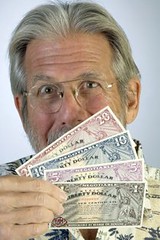 Federal prosecutors go to court in North Carolina on Monday in an attempt to obtain government ownership of an estimated $7 million in "Liberty Dollars" and silver bullion seized as contraband at a private mint in Coeur d'Alene.
Federal prosecutors go to court in North Carolina on Monday in an attempt to obtain government ownership of an estimated $7 million in "Liberty Dollars" and silver bullion seized as contraband at a private mint in Coeur d'Alene.
The forfeiture action comes 17 days after a jury in U.S. District Court in Statesville, N.C., convicted Bernard von NotHaus of conspiring against the U.S. government and manufacturing and selling counterfeit coins.
The case against the 67-year-old is believed to be the first time the Justice Department has brought a successful criminal prosecution against someone minting, selling and circulating coins in direct competition with the U.S. Mint and Federal Reserve.
The coins and silver, gold, platinum and copper that will be the focus of the forfeiture hearing are owned by von NotHaus and an estimated 250,000 purchasers throughout the United States who left their Liberty coins at Sunshine Minting for safekeeping, not realizing they would be seized as contraband, said Michel, of Charlotte, N.C.
The jury conviction of von NotHaus comes six years after the start of a joint investigation by the FBI and U.S. Secret Service into his nationwide Liberty Dollar operation.
During that time, von NotHaus went from promoting private coinage to promoting marijuana as a religious drug. He started the "Free Marijuana Church" in Honolulu, giving away joints and calling himself a "high priest" who had used pot for 40 years.
In 1998, while living in Hawaii, von NotHaus founded NORFED (the National Organization for the Repeal of the Federal Reserve Act and Internal Revenue Code) and began printing his own currency and minting coins.
His Liberty coins, manufactured at the mint in Coeur d'Alene, were marked with a "$," the word "dollar," USA and "Trust in God" instead of "In God We Trust," which is found on U.S. coinage.
The private coin and currency operation would be to the Federal Reserve what FedEx became to the U.S. Postal Service, von NotHaus boasted a decade ago.
Quickly, von NotHaus and NORFED became icons in anti-tax and radical sovereign citizen movements throughout the United States.
The criminal indictment brought against von NotHaus only involved coins he manufactured, not the companion paper currency.
Included on the forfeiture list are 8 tons of precious metals, including 168,599 silver Liberty Dollars in various denominations, an additional 1,000 pounds of silver bullion and 3,039 pounds of copper coins.
Initially, the value of silver in the Liberty Dollars was less than their face value, and von NotHaus eagerly took Federal Reserve notes for their purchase. Over the past years, the value of silver has risen from $20 to about $35 an ounce, so the government-seized contraband now has a higher value.
With the Liberty Dollars now viewed as contraband by the federal government, their numismatic value to some coin collectors is reportedly skyrocketing.
"They're sort of treating these Liberty Dollars like they were cocaine – you know, illegal," Michel said. "That's certain to drive the price up."
To read the complete article, see:
Bogus coins, bullion seized in CdA focus of federal action
(www.spokesman.com/stories/2011/apr/03/bogus-coins-bullion-
seized-in-cda-become-focus-of/)
ARTICLE PROFILES ROSA NEPHEW'S COIN REPRODUCTIONS
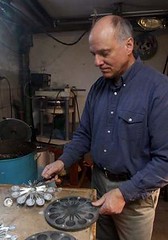 Charles Doyle's garage is, like many others, a catch-all for the detritus of suburban life. A raft of Bounty paper towels sits on one shelf, a big box of Milk-Bone dog biscuits sits on another. Propped against a wall is a Miller Genuine Draft sign.
Charles Doyle's garage is, like many others, a catch-all for the detritus of suburban life. A raft of Bounty paper towels sits on one shelf, a big box of Milk-Bone dog biscuits sits on another. Propped against a wall is a Miller Genuine Draft sign.
But within that garage, a visitor can hold a coin not far removed from ones that passed through the hands of Alexander the Great, Julius Caesar or George Washington. For in one corner, Doyle continues an artistic and historical pursuit begun by his uncle but derailed by a spate of bad publicity some five decades ago. In doing so, he's resurrecting both world and personal history — and adding to the region's educational resources.
"To me, it's researching the history of the coins," Doyle, 59, said. "That's what I enjoy."
The coins are replicas of ancient Greek and Roman tender, as well as money that circulated during this nation's early days. A widower, Doyle returned to the craft of crafting rare coins several years ago when his engineering job at IBM then NXP Semiconductors in Dutchess County seemed in jeopardy. Since he was laid off in 2009, it's become a full-time endeavor.
He started casting coins as a teenager under the eye of his uncle, Peter Rosa, a World War II veteran and former Merchant Marine seaman. At its 1960s height, Becker Reproductions — named for a 19th-century German forger — was selling some 250,000 coins in 40 countries, according to Doyle's website. By then, Rosa had moved his operation from the Bronx to New Rochelle.
But Rosa became too good, according to Doyle's recounting. He refused to mar his coins' artistry by stamping "copy" on their faces. Trade magazines then rejected his advertisements. The dispute was credited in part for the passage of the federal Hobby Protection Act in 1969, which required the notation.
Doyle's pieces are marked. Plus their size and weight are giveaways the reproductions are just that — an assertion echoed by an expert.
Those who are "numismatically savvy " know they are not holding an original when they pick up a replica, Rod Gillis said. Gillis is an educator with the Colorado-based American Numismatic Association.
Doyle's work largely depends on the collection of plaster impressions amassed by his uncle. During stops in England with the Merchant Marine, Rosa often went to the British Museum in London. There, he ordered essentially souvenir impressions from the museum's extensive (and authentic) coin collection. From those he fashioned molds into which molten metal is poured.
Rosa died in 1990 from cancer. Faded cigarette boxes on a work bench in Doyle's garage, Winston and Newport among them, hold dies and models used to make the replicas. For Doyle, a Navy veteran and father of two, the 550-degree liquid pewter he pours into the molds is a link to his past, as well as an economic grip on his future.
"He was like a father and a good friend. When I was a kid, I dreamed about doing it," Doyle said. "I just couldn't have all his stuff thrown out."
To read the complete article, see: Putnam Valley artisan crafts replica ancient coins (www.lohud.com/article/20110402/NEWS04/104020336/Putnam-Valley-artisan-crafts-replica-ancient-coins)
THE BOOK BAZARRE
ARMY DOG WINS AUSTRALIA'S PURPLE CROSS FOR ANIMALS
It's a tale worthy of a movie script.
Sarbi, the army explosives detection dog, goes missing in action in Afghanistan. After 13 months lost in a war zone, she is found by chance and brought home to be awarded the RSPCA Purple Cross for bravery.
The labrador's adventure began back in 2008 when she was out on patrol in Afghanistan's Oruzgan province with her handler.
Sarbi and her comrades were attacked by insurgents in a battle which left nine soldiers, including her handler, wounded.
During the battle, in which Lance Corporal Mark Donaldson earned the Victoria Cross, a rocket-propelled grenade broke the lead that tethered Sarbi to her handler.
After numerous attempts to find the dog, she was declared missing in action and her handler returned to Australia thinking he would never see her again.
Thirteen months later a US soldier out on patrol in the area where Sarbi went missing spotted a black labrador walking with a local villager, an unusual sight in Afghanistan.
A quick check of her microchip confirmed the dog was indeed Sarbi, and after a long stay in quarantine she was returned to Australia and reunited with her handler.
Sarbi is only the eighth animal to receive the prestigious Purple Cross for outstanding service to humans. She joins the likes of Private John Simpson Kirkpatrick's famous donkey Murphy who helped save wounded ANZAC soldiers during the battle of Gallipoli.
RSPCA President Lynne Bradshaw presented Sarbi with the medal on Tuesday at a ceremony attended by Chief of the Army, Lieutenant-General Ken Gillespie.
To read the complete article, see:
Brave army dog Sarbi wins Purple Cross
(news.smh.com.au/breaking-news-national/brave-army-dog-sarb
i-wins-purple-cross-20110405-1d2nf.html)

The RSPCA Australia Purple Cross Award recognises the deeds of animals that have shown outstanding service to humans, particularly if they showed exceptional courage in risking their own safety or life to save a person from injury or death.
The Award was named to honour the Purple Cross Society which was established soon after the outbreak of World War II to raise funds for the supply of gear and veterinary treatment for the Light Horse Brigade. The Purple Cross Society was disbanded in 1971 and the RSPCA in Victoria was charged with preserving and displaying the flag of the Society, which now hangs in the Council Room of the RSPCA Victoria headquarters. As a tribute to the memory of all of Australia's war horses, the RSPCA Australia exceptional animal award is known as the Purple Cross Award. Recipients of the Purple Cross Award receive a Purple Cross medal and a certificate.
To read the complete article, see
RSPCA PURPLE CROSS AWARD
(www.rspca.org.au/what-we-do/awards/rspca-purple-cross-award.html)
SOMERSET COIN HOARD IMAGES
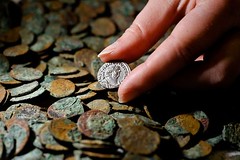 Fifty thousand Roman coins found in a field in Somerset, England, in 2010 (including the artifacts above) amount to the largest hoard of coins discovered in a single vessel—and the second largest hoard of ancient coins ever found in Britain, according to British Museum experts.
Fifty thousand Roman coins found in a field in Somerset, England, in 2010 (including the artifacts above) amount to the largest hoard of coins discovered in a single vessel—and the second largest hoard of ancient coins ever found in Britain, according to British Museum experts.
The coins, along with recently discovered Iron Age gold jewelry—both found by amateur treasure hunters—will be acquired by museums, thanks to a series of grants and donations, officials recently announced. The coins will go to England's Museum of Somerset, which will put them on display after it reopens this summer.
The haul, most of which has been cleaned and restored, contains nearly 800 coins minted by Carausius, a Roman general who declared himself emperor of Britain in A.D. 286 and ruled for seven years before being assassinated by his treasurer.
During those seven years, Carausius spread his rule in part through propaganda—for example, by issuing high-quality silver coins bearing his likeness, such as the one pictured above.
The find also contained coins showing Rome's mythical founders, Romulus and Remus, suckling a wolf—a scene never before found on Carausius coins. Carausius may have used the image to link himself with the historical Roman Empire.
"He was a great propagandist," British Museum archaeologist Sam Moorhead told National Geographic News. "He basically introduced that coin as soon as he came to the throne."
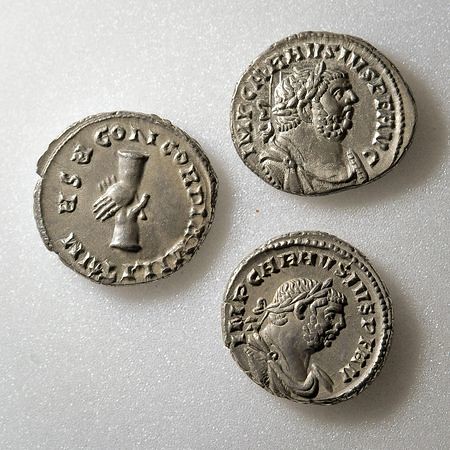
To read the complete article, see:
Old Money
(news.nationalgeographic.com/news/2011/04/pictures/110404-
gold-treasure-iron-age-roman-coins-british-science)
FEATURED WEB SITE: COIN MATERIALS
This week's Featured Web Site is suggested by Larry Dziubek. It's a segment of Theodore W. Gray's web site on the elements devoted to coins made of different materials.
An astonishing number of different metals have been used to make coins over the centuries. My collection represents only a fraction of these metals, mainly because coins made from some of the more exotic metals can be extremely expensive.
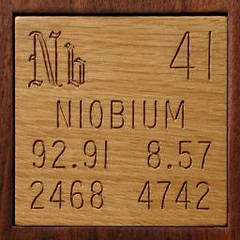
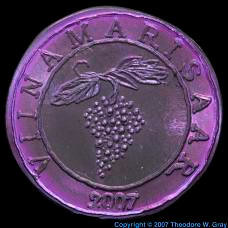
www.theodoregray.com/periodictable
/Elements/CoinsGroup/
